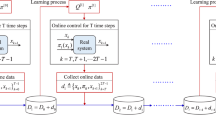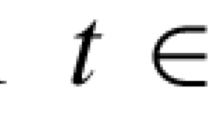Abstract
QR decomposition (QRD) is of fundamental importance for matrix factorization in both real and complex cases. In this paper, by using zeroing neural dynamics method, a continuous-time model is proposed for solving the time-varying problem of QRD in real-time. The proposed dynamics use time derivative information from a known real or complex matrix. Furthermore, its theoretical analysis is provided to substantiate the convergence and effectiveness of solving the time-varying QRD problem. In addition, numerical experiments in four different-dimensional time-varying matrices show that the proposed model is effective for solving the time-varying QRD problem both in the case of a real or a complex matrix as input.





Similar content being viewed by others
References
Anaraki FP, Becker S (2019) Improved fixed-rank Nyström approximation via QR decomposition: practical and theoretical aspects. Neurocomputing 363:261–272
Anderson M, Ballard G, Demmel J, Keutzer K (2011) Communication-avoiding QR decomposition for GPUs. In: Proceedings of IEEE international parallel distributed processing symposium, pp 48–58
Baumann M, Helmke U (2003) Singular value decomposition of time-varying matrices. Future Gen Comput Syst 19:353–361
Brookes M (2020) The matrix reference manual. http://www.ee.imperial.ac.uk/hp/staff/dmb/matrix/intro.html
Chang RC, Lin C, Lin K, Huang C, Chen F (2010) Iterative QR decomposition architecture using the modified gram-schmidt algorithm for MIMO systems. IEEE Trans Circuits Syst I Regul Pap 57(5):1095–1102
Charif F, Benchabane A, Bennia A (2018) A simplified architecture of the Zhang neural network for Toeplitz linear systems solving. Neural Process Lett 47:391–401
Chen J, Zhang Y (2020) Online singular value decomposition of time-varying matrix via zeroing neural dynamics. Neurocomputing 383:314–323
Chen T, He H, He C, Chen G (2019) New parameter-identification method based on QR decomposition for nonlinear time-varying systems. J Eng Mech. https://doi.org/10.1061/(ASCE)EM.1943-7889.0001555
Gatu C, Kontoghiorghes EJ (2003) Parallel algorithms for computing all possible subset regression models using the QR decomposition. Parallel Comput 29(4):505–521
Ghaderyan P, Abbasi A, Ebrahimi A (2018) Time-varying singular value decomposition analysis of electrodermal activity: a novel method of cognitive load estimation. Measurement 126:102–109
Graham A (2018) Kronecker products and matrix calculus with applications. Dover Publications, Mineola
Guo D, Nie Z, Yan L (2017) Novel discrete-time Zhang neural network for time-varying matrix inversion. IEEE Trans Syst Man Cybern Syst 47(8):2301–2310
Gupta AK (2014) Numerical methods using MATLAB. MATLAB solutions series. Springer Press, New York
Horn RA, Johnson CR (1991) Topics in matrix analysis. Cambridge University Press, New York
Jin L, Zhang Y, Li S, Zhang Y (2016) Modified ZNN for time-varying quadratic programming with inherent tolerance to noises and its application to kinematic redundancy resolution of robot manipulators. IEEE Trans Ind Electron 63(11):6978–6988
Jin L, Zhang Y (2016) Continuous and discrete Zhang dynamics for real-time varying nonlinear optimization. Numer Algorithms 73:115–140
Kerr A, Campbell D, Richards MA (2009) QR decomposition on GPUs. In: Kaeli DR, Leeser M (eds) Proceedings of 2nd workshop on general purpose processing on graphics processing units, GPGPU 2009, Washington, DC, USA, March 8, 2009, vol 383 of ACM international conference proceeding series. ACM, pp 71–78
Kokkinos Y, Margaritis KG (2018) Managing the computational cost of model selection and cross-validation in extreme learning machines via Cholesky. SVD, QR and eigen decompositions. Neurocomputing 295:29–45
Liang Z, Shi P (2004) An efficient and effective method to solve kernel Fisher discriminant analysis. Neurocomputing 61:485–493
Liao B, Zhang Y (2014) Different complex ZFs leading to different complex ZNN models for time-varying complex generalized inverse matrices. IEEE Trans Neural Netw Learn Syst 25(9):1621–1631
Liao B, Zhang Y (2014) From different ZFs to different ZNN models accelerated via Li activation functions to finite-time convergence for time-varying matrix pseudoinversion. Neurocomputing 133:512–522
Liu C, Tang C, Yuan L, Xing Z, Zhang Y (2016) QR decomposition architecture using the iteration look-ahead modified gram-Schmidt algorithm. Dev Syst IET Circuits 10(5):402–409
Luethi P, Studer C, Duetsch S, Zgraggen E, Kaeslin H, Felber N, Fichtner W (2008) Gram-Schmidt-based QR decomposition for MIMO detection: VLSI implementation and comparison. In: Proceedings of APCCAS 2008–2008 IEEE asia pacific conference on circuits and systems, pp 830–833
Penrose R (1956) On a best approximate solutions to linear matrix equations. Proc Camb Philos Soc 52:17–19
Petković MD, Stanimirović PS, Katsikis VN (2018) Modified discrete iterations for computing the inverse and pseudoinverse of the time-varying matrix. Neurocomputing 289:155–165
Stanimirović PS, Katsikis VN, Li S (2018) Hybrid GNN-ZNN models for solving linear matrix equations. Neurocomputing 316:124–134
Stanimirović PS, Katsikis VN, Li S (2019) Higher-order ZNN dynamics. Neural Process Lett 1–25
Stanimirovic PS, Pappas D, Katsikis VN, Stanimirović IP (2012) Full-rank representations of outer inverses based on the QR decomposition. Appl Math Comput 218(20):10321–10333
Stanimirović PS, Katsikis VN, Zhang Z, Li S, Chen J, Zhou M (2019) Varying-parameter Zhang neural network for approximating some expressions involving outer inverses. Optim Methods Softw 1–27
Stanimirović PS, Katsikis VN, Li S (2019) Integration enhanced and noise tolerant ZNN for computing various expressions involving outer inverses. Neurocomputing 329:129–143
Ullah I, Nisar H, Raza H, Qasim M, Inam O, Omer H (2018) QR-decomposition based SENSE reconstruction using parallel architecture. Comp Biol Med 95:1–12
Wang G, Wei Y, Qiao S (2018) Generalized inverses: theory and computations, developments in mathematics, vol 53. Springer, Singapore
Xiao L (2015) A finite-time convergent neural dynamics for online solution of time-varying linear complex matrix equation. Neurocomputing 167:254–259
Xiao L (2016) A nonlinearly-activated neurodynamic model and its finite-time solution to equality-constrained quadratic optimization with nonstationary coefficients. Appl Soft Comput 40:252–259
Yang L, Ren G, Qiu Z (2010) Novel noise reduction algorithm for LS channel estimation in OFDM system with frequency selective channels. In: Proceedings of IEEE international conference on communication systems, pp 478–482
Ye Q, Ye N, Yin T (2015) Fast orthogonal linear discriminant analysis with application to image classification. Neurocomputing 158:216–224
Yu J, Rui Y, Tao D (2014) Click prediction for web image reranking using multimodal sparse coding. IEEE Trans Image Process 23(5):2019–2032
Yu J, Tan M, Zhang H, Tao D, Rui Y (2019) Hierarchical deep click feature prediction for fine-grained image recognition. IEEE Trans Pattern Anal Mach Intell 1–1
Zhang Y, Yi C (2011) Zhang neural networks and neural-dynamic method. Nova Science Publishers Inc, New York
Zhang Y, Jin L, Guo D, Yin Y, Chou Y (2015) Taylor-type 1-step-ahead numerical differentiation rule for first-order derivative approximation and ZNN discretization. J Comput Appl Math 273:29–40
Zhang Y, Huang H, Yang M, Ling Y, Li J (2020) New zeroing neural dynamics models for diagonalization of symmetric matrix stream. Numer Algorithms 85:849–866
Zhao C, Chen Y, Wei Z, Miao D, Gu X (2019) QRKISS: a two-stage metric learning via QR-decomposition and KISS for person re-identification. Neural Process Lett 49:899–922
Acknowledgements
Predrag Stanimirović gratefully acknowledges support from the Ministry of Education, Science and Technological Development, Republic of Serbia, Grant No. 174013.
Author information
Authors and Affiliations
Corresponding author
Additional information
Publisher's Note
Springer Nature remains neutral with regard to jurisdictional claims in published maps and institutional affiliations.
Rights and permissions
About this article
Cite this article
Katsikis, V.N., Mourtas, S.D., Stanimirović, P.S. et al. Continuous-Time Varying Complex QR Decomposition via Zeroing Neural Dynamics. Neural Process Lett 53, 3573–3590 (2021). https://doi.org/10.1007/s11063-021-10566-y
Accepted:
Published:
Issue Date:
DOI: https://doi.org/10.1007/s11063-021-10566-y




